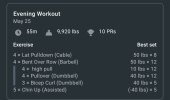I do see most of the "smart guys" out there today (the PhD's who lift crowd) really recommend pushing carbs as much as possible for maximizing muscle growth during a bulk.
Smart Ketogenic Guys, PhD Who Lift
One of the issue with many "Smart Guy" PhDs who lift and push carbohdyrates is that many lack knowlege when it come to Training on a Ketogenic Diet.
Not only do that lack the book smarts, they have no practical experience with it.
Anecdotal Data
1) Bill "Peanuts" West
As I noted in a previous post, Bill West got his "Peanuts" nickname from drinking Peanut Oil to gain weight back in the 1960's.
As the story goes, West didn't have much money so he decided to drink Peanut Oil.
West bulked with this method and was one of was one fo the strogest on the "Orginal Westside Powerlifting" team.
My Personal Experience
I have posted this information multiple times.
Due to a metabolic condition, I went on the Ketogenic Diet and Intermittent Fasting in 2016. I dropped 17 lbs.
The Ketogenic Diet helped. Howevever, mainly it was because I dropped my calorie intake by only eating two meals a day.
Gaining The 17 lb Back
After losing the weight (which was not my objective), I decided to gain the weight back.
Since I was on the Ketogenic Diet, that meant that I was limited to 50 gram of Carbohydrate per day.
My Protein intake was limted to 25% or less of my Daily Intake.
The only method left to increase my caloric intake was Fat.
I increase my meals back to three a day.
I added more Fat to my meals and had what I term as "Fat Shots"; MCT Oil with Avocado or Liquid Coconut Oil, three times a day, between meals. The three "Fat Shots" alone increase my daily intake by 756 calorie.
Adding to that was my third meal with lots of fat.
In doing so, I gained back the 17 lbs.
Research on Gaining Weight On a Ketogenic Diet
1) There is very little research on how to gain weight on a Ketogenic Diet.
Prior to my going on a "Ketogenic Gain Weight Diet", I research how to do it and make it work.
There is virtually nothing on it. All that I had was the anecdotal Bill "Peanuts" West data.
The majority of information on the Ketogenic Diet and belief is that it is a "Weight Loss Diet".
With that said, ....
Calorie Count
The bottom line is that no matter what Diet you are on, Calories Count.
If you consume more calories, even on a Ketogenic Diet, you will gain weight.
If you decrese your calorie intake on any diet, you will lose weight; Mark Haub, MS Nutrition Instructor at Kasas State, demonstrated that. Haub lost 27 pound on the Twinkee Diet.
Lack of Knowledge
The majority of "Smart Guys" have little to no experience in how to gain weight, let alone how to train on a Ketogenic Diet.
As Dr John Berardi, PhD Nutrition, once commented, "It is hard to address and provide any information on something you have little knowledge or personal experince in."
Ketogenic Diet Training
A secondary issue is that most individual don't understand how to write and perform a program that is specific for individual on a Ketogenic Diet.
This has been addressed in previous post.
The key is to understand the...
Three Energy Systems
1) Phosphagen Energy System
This system is primarly used with Maximum Strength, Power and Speed Training. Repetition Sets that are low and take 15 seconds or less employ this system.
That means individual on a Ketogenic Diet or the Standard High Carbohydrate Diet will perform equally as well.
2) Glycolytic Energy System
Sports and Activities that are over 30 seconds and up to around 2 minutes need and utilize more glycogen, carbohydratres.
With that said, research by Rachael Gregory indicated that Athletes on a Low Carbohydrate, Ketogenic Diet, performed equally as well; once they adapted to the Lower Carbohydrate/Ketogenic Diet.
A Low Carbohydrate Diet, CrossFit
A low-carbohydrate ketogenic diet (LCKD) is a popular approach to weight and fat loss. CrossFit is a high-intensity power training (HIPT) type exercise for all levels of age and fitness that has gained recognition as one of the fasting growing sports in America. No previous research has been...

commons.lib.jmu.edu
This is an interesting research article. As someone on Keto, I'd like to belive it but...
1) Based on other research, it does not make sense.
2) From my personal experience, it is contra-indicated.
Bodybuilding
This fall more into the Glycolytic Energy System.
Based on reseach and my personal experience, Cluster Hypertrophy Training is effective at "Gaming" Hypertrophy Training.
Cluster Sets ensure Hypertrophy Training is maintained in the Phosphagen Energy Stystem.
Cluster Hypertrophy Set Training research by Dr Jonathan Oliver demonstrated this produce "Functional Hypertrophy"; athletes were able to maintain/increase Power and Maximum Power while increasing Muscle Mass with this method.
Traditional Bodybuilding/Hypertrophy alone increase Muscle Mass at the expense of Power and Strength.
Oxidative Energy System
Most of the research on the Ketogenic Diet revolves around it effectiveness with Endurance Athletes; their interest in more in maintain an lower body weight.
Take Home Message
1) Lack of Knowledge
a) Very few individual understand what a Ketogenic Diet. I didn't initially.
b) Very few can maintain it. Any Diet that is extremely restrictive is hard to adhear to.
2) Gaining Weight On Keto
a) Most view it as a "Weight Loss Diet".
b) Most are "Fatphobic", they view is as unhealty.
3) Ketogenic Diet Strength Training
The issue is that most don't know how to write a Ketogenic Diet Strength Training Program for that employs the right Energy System.
Training on a Ketogeinic Diet require a different approach.
It took me a year of researching that to figure it out.





